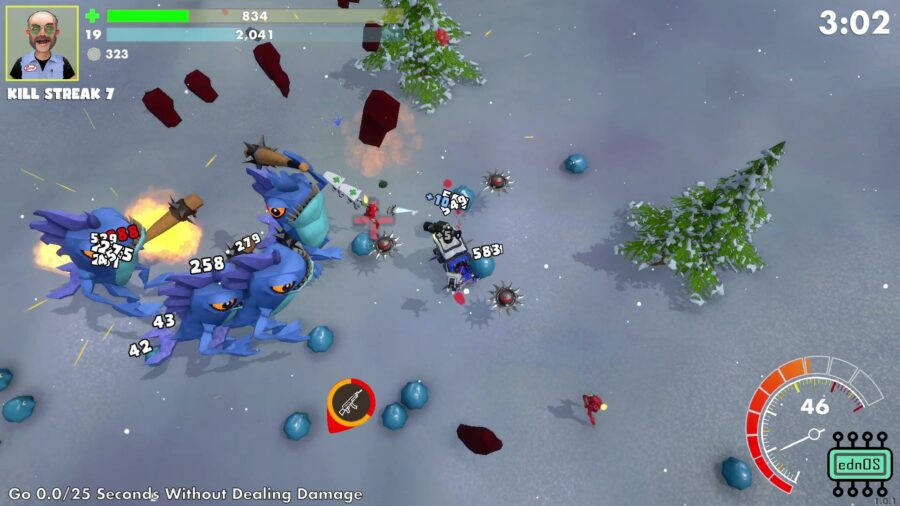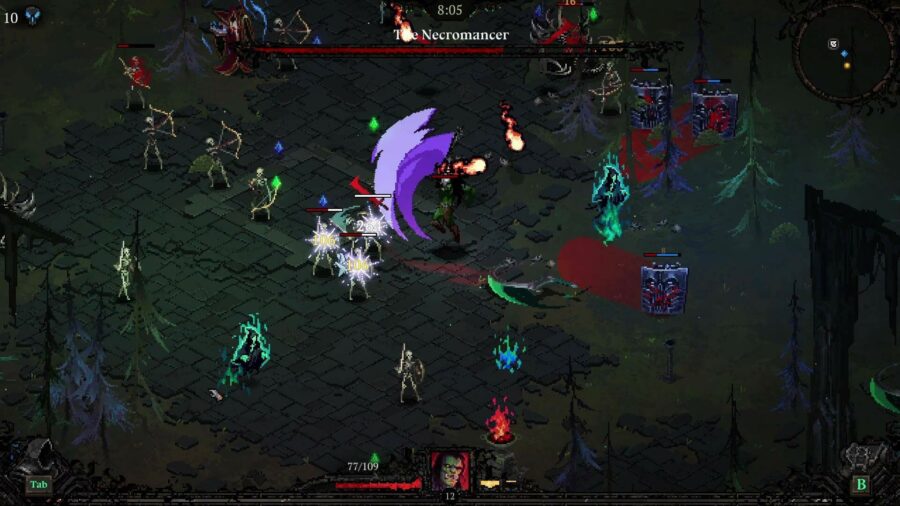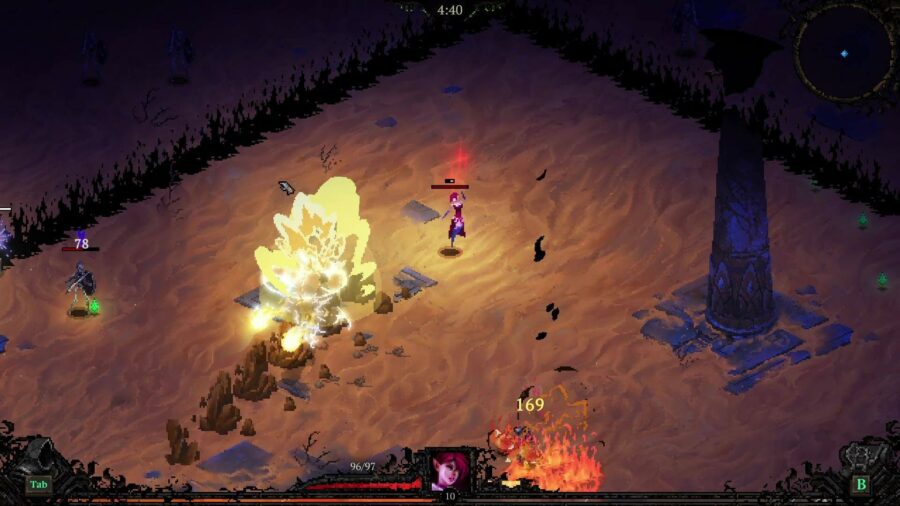I haven’t written as many columns about “bullet heaven” games as I could have. Almost as soon as Vampire Survivors hit it big, other studios started making variations on its theme. By now, there’s a new game in VS’s lane every couple of weeks; I play a lot of them; and to my surprise, many of them turn out to be pretty good. They’re meant to be cheap, repetitive, and challenging, and most of the developers who’re making these games seem to understand the assignment.
I mentioned this a few weeks ago, but one of the things that fascinates me about the bullet heaven genre is that nobody seems interested in simply cloning Vampire Survivors. The closest anyone’s come might be HoloCure, and even it has a couple of unique features like its farming minigame. Most other bullet heaven games seem to treat VS like a useful starting point, then go off in their own direction.
In Earl vs. the Mutants, that direction is ‘80s grindhouse movies. I’ve described it to a couple of people as a Tremors sequel where Burt Gummer joined Twisted Metal. (Alternatively, it’s a game in which you’re the Hell that’s coming to Frogtown.) You’re a blue-collar guy who works as a post-apocalyptic exterminator, which means you’re taking on armies from behind the wheel of your personal killdozer.
On each map, Earl enters play with a tricked-out car and goes up against waves of enemies, from mad cultists to toxic zombies to giant fish-people. If you can survive for 10 minutes, you confront the local mutant warlord, who enters play in their own customized murder-mobile.
There was a period in the late ‘90s where it seemed like a lot of Western game developers all watched Death Race 2000 at the same time, which led to the creation of “vehicular action” games like Twisted Metal, Carmageddon, and Vigilante 8. Earl vs. the Mutants hearkens back to that. It offers a couple of different control schemes, but you’re still driving a car, so you have to take acceleration, cornering, momentum, and local topography into account. It gives Earl a unique difficulty curve.

Early in a run, Earl is a roadkill simulator, as driving over a mutant does more reliable damage than any of your weapons. As you go, you’re gradually awarded better guns and drones that ramp up your damage output. Smashing into mutants never goes out of style, but it quickly takes a backseat to auto-targeted shotguns or a full-auto grenade launcher.
Having said that, I had a hard time with the first half-hour of Earl vs. the Mutants, as there’s a real disconnect between what it wants you to do and what’s actually viable. Most of the available cars in the game are actually pretty fragile at the start of a run. You can rack up a quick body count by doing donuts in the middle of an oncoming mob, but you’ll take enough stray melee hits in the process that it’s rarely worth the risk. The safer play is to use hit-and-run tactics, level up, and collect defensive bonuses until no single mutant can do much more than scratch your paint.
Once I figured that out, I had a lot more fun with Earl, but immediately ran into a second problem: it’s really short. Granted, it’s $7, but at time of writing, it’s only got 1 character, 4 cars, 3 maps, and 3 levels of difficulty. Even by comparison to other bullet heaven games, which tend to have simple and repetitive core loops, you run out of new things to do in a hurry.
Earl vs. the Mutants has potential, but feels like an early draft of itself. With some post-launch support, it could turn into something special. For right now, it’s a cheap way to get your vehicular homicide fix, but it’s hard to imagine playing it past the 4-hour mark.
—

Death Must Die, admittedly, is old news. It came out last November in Steam Early Access and quickly got a small cult following. Personally, I bounced off of it, as it gets off to a slow start; your first character is a slow-moving knight with a boring game plan.
I picked DMD back up in the last couple of weeks and found out that I’d given up about 15 minutes early. If you stick it out with Default Sword Guy for a couple of runs, you unlock 5 more characters, most of whom are more entertaining than he is.
In DMD, the god of Death has gone out of control. Instead of taking people at their appointed time, he’s started killing them for the sheer fun of it. As a result, mortals make regular pilgrimages to the isolated High Mount, from which they can travel to Death’s home and confront him directly. No one has survived the trip.
Now, Death’s finally gotten the other gods to the point where they’re willing to oppose him directly. You play DMD as a party of six adventurers who’ve all come to the High Mount for their own reasons, and then discover they have divine backup. WIth the help of the gods, one of the 6 might be the hero who finally kills death.
DMD is essentially a dungeon crawler with no dungeon. Each run drops you into a flat plane with a small army of incoming monsters, where you can mow them down for experience and gold.
Each boss you take down gives you currency for permanent character upgrades, while you can find or buy equipment that further improves your stats. At each new level, you can select a boon from one of 3 gods, which gives you powerful new abilities that last for the rest of that particular run.
DMD’s primary mechanic during combat is that your dash, which recharges quickly and offers a short invincibility window. It lets you create some space and dodge past enemies’ attacks, which is just useful at first and rapidly becomes critical. By the time you reach the second boss, your mastery of the dash is most of what keeps you alive.
There’s no point in DMD at which you accumulate enough firepower where you don’t have to pay attention. Even if you luck into a really good early build, you still have to dodge incoming attacks or you’ll end up smeared across the landscape. It’s like Diablo on fast-forward, and it’s surprisingly successful.

I’d only say “surprisingly” because DMD feels too complicated by half. It’s got the “too many stats” issue that frequently crops up with number-crunchy action-RPGs, where it’s difficult to tell at a glance whether a new piece of gear or passive ability is actually a meaningful upgrade. You eventually get a feel for which stats actually matter, but you could ditch or consolidate half of these modifiers/powers and lose nothing.
Just the same, DMD manages to capture some of the flavor from two separate, addictive genres. It’s hard to put down once you start, and the characters’ individual upgrade trees introduce enough variability that they all end up feeling usefully different.
If there’s a commonality between DMD and Earl vs. the Mutants, it’s about how both games treat a dire situation like it’s another day at the office. DMD’s story sounds like an existential crisis in the making, but nobody’s taking it that seriously. The game’s mood does a 180 after you unlock your second character, Merris, who’s just happy to be here, and the next few unlocks continue that general theme.
I wouldn’t go as far as to call DMD a parody, but I got a lot of laughs out of various characters’ absolute refusal to engage with the sort of story they’re in. Imagine a typical Soulslike, but after the first hour, everybody went to therapy.
Death Must Die has a vague roadmap at time of writing that might see it leave Early Access around the end of the year. It’s got a few issues it could stand to sort out, but if it manages to stick the landing, DMD could be the next great bullet heaven game.



